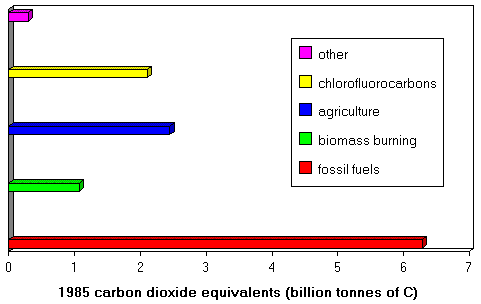LE FastCounter
So what if global warming occurs?
LE
FastCounter
So what if global
warming occurs?
The Earth's climate
has changed radically many times in our planet's history. The Cretaceous
era, during which dinosaurs reigned supreme, was considerably hotter and
moister than today's globally-averaged climate; on the other hand,
Quaternary ice ages formed the glaciers that carved much of the world's
most spectacular scenery. Interglacial warm periods allowed, for example,
the Vikings to grow grapes in Iceland, as well as their settlement of
Greenland and Newfoundland – which were abandoned as the climate once
again cooled.
Climate change has been, and will continue to be, an
integral part of the
While some
regions of the globe will benefit from a warmer climate, many will not –
and overall, the losses will most likely outweigh the gains. A list of
costs includes:
desertification.
Climate models also suggest that severe storms, such
as
winter blizzards or summer hurricanes, will also be more intense. In the
United States, over the past decade we have been struck by unprecedented
snowstorms, hurricanes, and tornadoes, with damages
mounting into the billions of dollars and considerable loss of life. Intense storms in the world's drylands can damage crops and sheet-erode the precious topsoil, paradoxically resulting in
Is global warming real?
Indicators such as cyclonic
storm intensities, tropical cyclone frequencies, heat waves, warmer
average seasonal temperatures, and measurable sea-level rise as witnessed
by eroding coastlines, together strongly suggest that global warming is
indeed occurring. Untutored critics of global warming who point to the
enormous blizzards striking the United States and Europe during the past
several winters as “proof” that warming is not occurring miss the real
point: such storms are simply
intense precipitation in a frozen state – and these are precisely the
storms predicted by global climate models for a warmer world. Indeed,
the warming signal has been diluted during much of the past three decades
through the cooling trend induced by industrial particulates, such as
sulfate aerosols. Now that industrialized nations are reducing these
emissions, the patterns associated with global warming are reasserting
themselves.
Global climate models show the warming phenomenon to be
more-intense in the polar regions than elsewhere. Recent evidence of an
overall thinning and seasonally-earlier break-up of the vast Antarctic
sea-ice sheets strongly supports such model results. In the figure below,
I show global anthropogenic CO2 emissions
for fossil fuels and cement, as billions of tonnes of carbon (C), from
1860 to 1982 (green); the Mauna Loa observatory's mean annual CO2 concentration measurements from 1958 to 1990
(red); the mean annual surface temperature for all Antarctic stations near
sea level having continuous data records from 1958 to 1987 (elevation
given in parentheses after the station name): Halley Bay (32 m), Faraday
(9 m), Mawson (16 m), Dumont D'urville (43 m), Mirny (30 m), and Casey (15
m). The temperature data have been increased to equivalent sea-level
temperatures using the dry adiabatic lapse rate (blue). The yellow line
is the temperature data after smoothing by a 100-year cubic spline; the
black curve is the temperature data after smoothing by a 20-year cubic
spline. (I obtained all data from the

Based on data from global climate models, the Intergovernmental Panel on Climate Change projects that global temperatures will rise by 1.5oC to 4.5oC under the scenario of a doubling of CO2 from preindustrial levels, a level likely to be reached by about 2030. While such a temperature rise may not seem particularly significant, consider that the last major ice age was globally only about 4oC colder than the present; the “little” ice age of the 1700s, which destroyed settlements in Iceland and froze European rivers, is estimated to have been globally just 1oC cooler than today.
The Greenhouse Effect
The term “greenhouse effect” is a misnomer for the real
problem – an intensification of the greenhouse effect that is resulting in
global warming. Global warming is due to the buildup of the
gases that trap heat in the atmosphere. These gases are largely
anthropogenic in origin. The greenhouse effect is the sum of
the interactions between: Below, I show anthropogenic greenhouse gas
emissions for 1985, expressed as carbon dioxide equivalents. Emission
categories (top), as billions of tonnes of carbon; percentage as carbon
dioxide equivalent (bottom). When narrowed down, the sources of global warming
are:
Without the greenhouse
effect, the earth would be about 33oC
cooler than it is – that is, for all practical purposes,
uninhabitable.

The Greenhouse Gases
The graphic below depicts the five main anthropogenic greenhouse gases, lists their sources, illustrates their projected increase until 2030, and shows their effectiveness compared to carbon dioxide. Note that while the concentration of chlorofluorocarbons (CFCs) is in the parts per billion (or 105 time less than the concentration of carbon dioxide), its effectiveness per molecule is 104 greater than CO2. In global terms, CFCs contributed 15% - 17% of the total warming effect in the 1980s; these are also the compounds known to be destroying the planet's stratospheric ozone layer.

 Back
Back
This site last updated April 14, 1998.